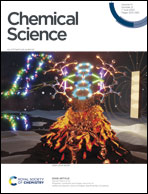Quantum chain amplification in nanocrystalline Dewar benzenes by intramolecular sensitization†
Abstract
Quantum chain reactions are characterized by the formation of several photoproducts per photon absorbed (ΦQC > 1) and constitute a promising signal amplification mechanism. The triplet-sensitized isomerization of Dewar benzene is known to undergo quantum chain reactions characterized by an adiabatic valence-bond isomerization to the excited state of Hückel benzene, which is able to transfer its triplet energy to a new ground state Dewar benzene that reacts to continue the chain. Given that diffusion-mediated energy transfer is the chain-limiting event in solution, we demonstrate here that reactions in crystals are significantly more efficient by taking advantage of energy transfer by a presumed exciton delocalization mechanism. Using Dewar benzenes with covalently attached, high energy triplet sensitizers we have demonstrated the efficiency of the solid state by the amplification of a quantum yield of ca. ΦQC ≈ 76 in acetonitrile solution to as much as ca. ΦQC ≈ 100–120 in submicron size specimens prepared by the re-precipitation method, and up to ca. ΦQC ≈ 300 with microcrystalline powders suspended in water.



 Please wait while we load your content...
Please wait while we load your content...